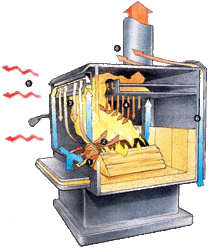Ok, my wife thinks I am a geek for putting more than a moments thought into this, but I am curious about how my wood stove works (as far as air flow, inlet air tubes/holes, secondary burn, etc). I told her that it must be because the man's brain is more analytical, and, therefore, smarter. Anyway, the first wood stove I really looked at was an old franklin type stove up at our hunting cabin. When you opened the door, you could see that the air flow/smoke just went right up the chimney. In my new Century stove, I am intrigued by the air tubes along the top of the box that have holes directed towards the front. The next thing I noticed was that air/smoke can't just go right up the chimney....I can't even see the chimney from opening the door. So I am assuming that the air must be directed around the top plate before it can exit, thereby increasing/improving(?) airflow around the logs.
I have been searching for diagrams that shows how the system works, but with no luck. Are other manufactures (non-cat) built with the same design, aside from minor proprietary tweaks? Is there anyone that could tell me where I can find this information? Part of my reasoning to find this out is so I can more efficiently use my stove, the other reasoning is that I am just curious too see what's going on.
Thanks for your help
Jeff Thornton
I have been searching for diagrams that shows how the system works, but with no luck. Are other manufactures (non-cat) built with the same design, aside from minor proprietary tweaks? Is there anyone that could tell me where I can find this information? Part of my reasoning to find this out is so I can more efficiently use my stove, the other reasoning is that I am just curious too see what's going on.
Thanks for your help
Jeff Thornton


